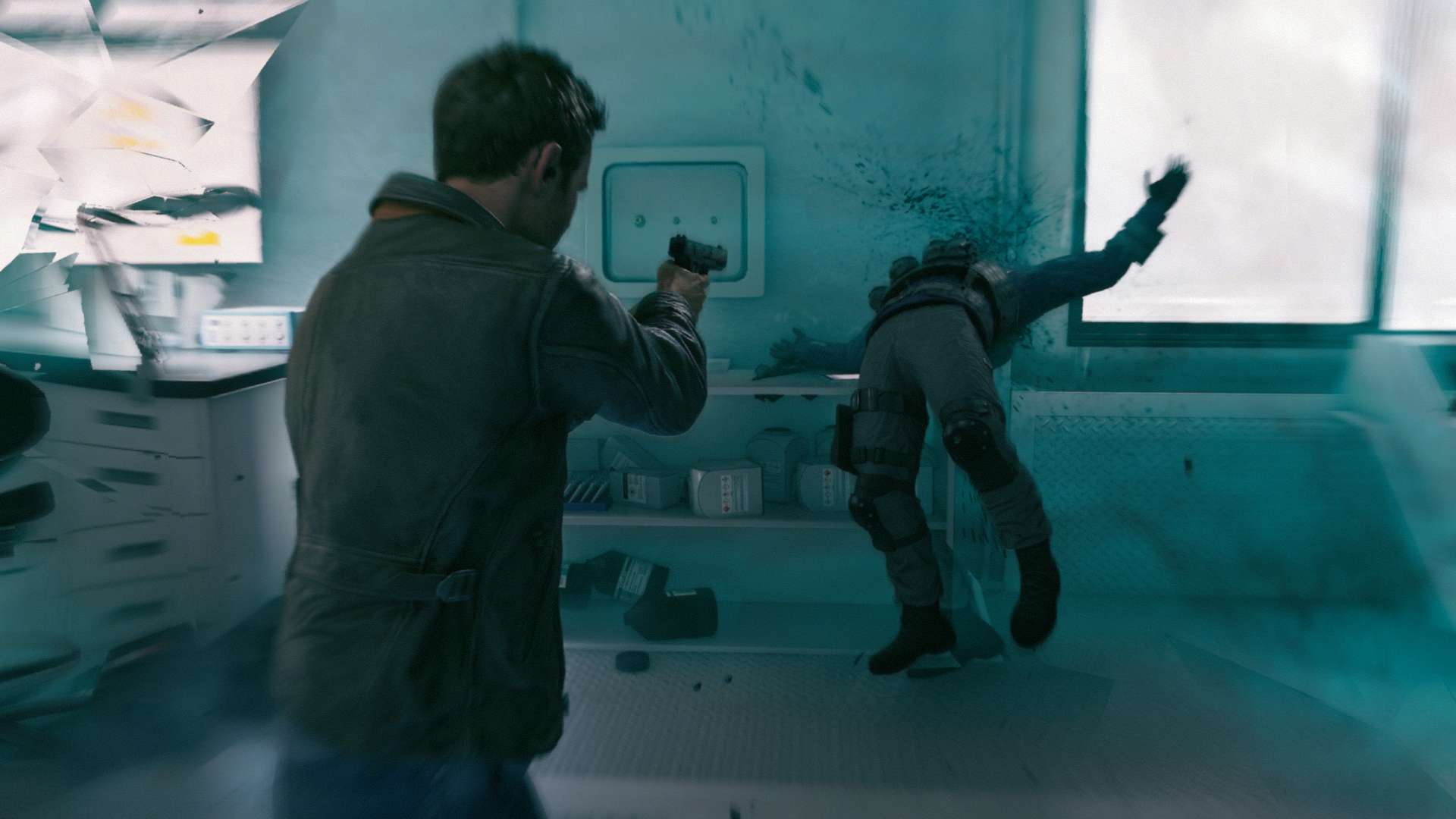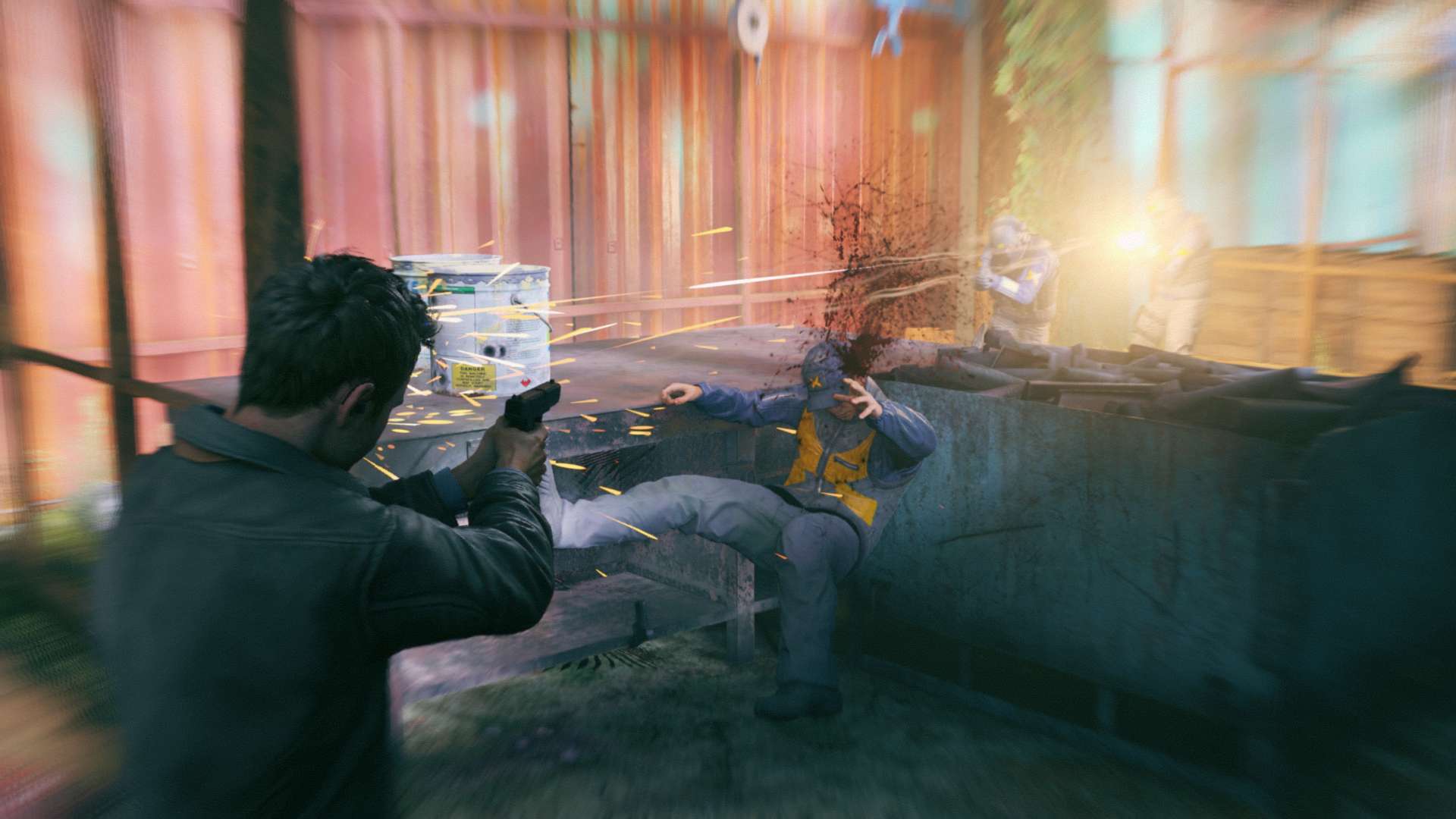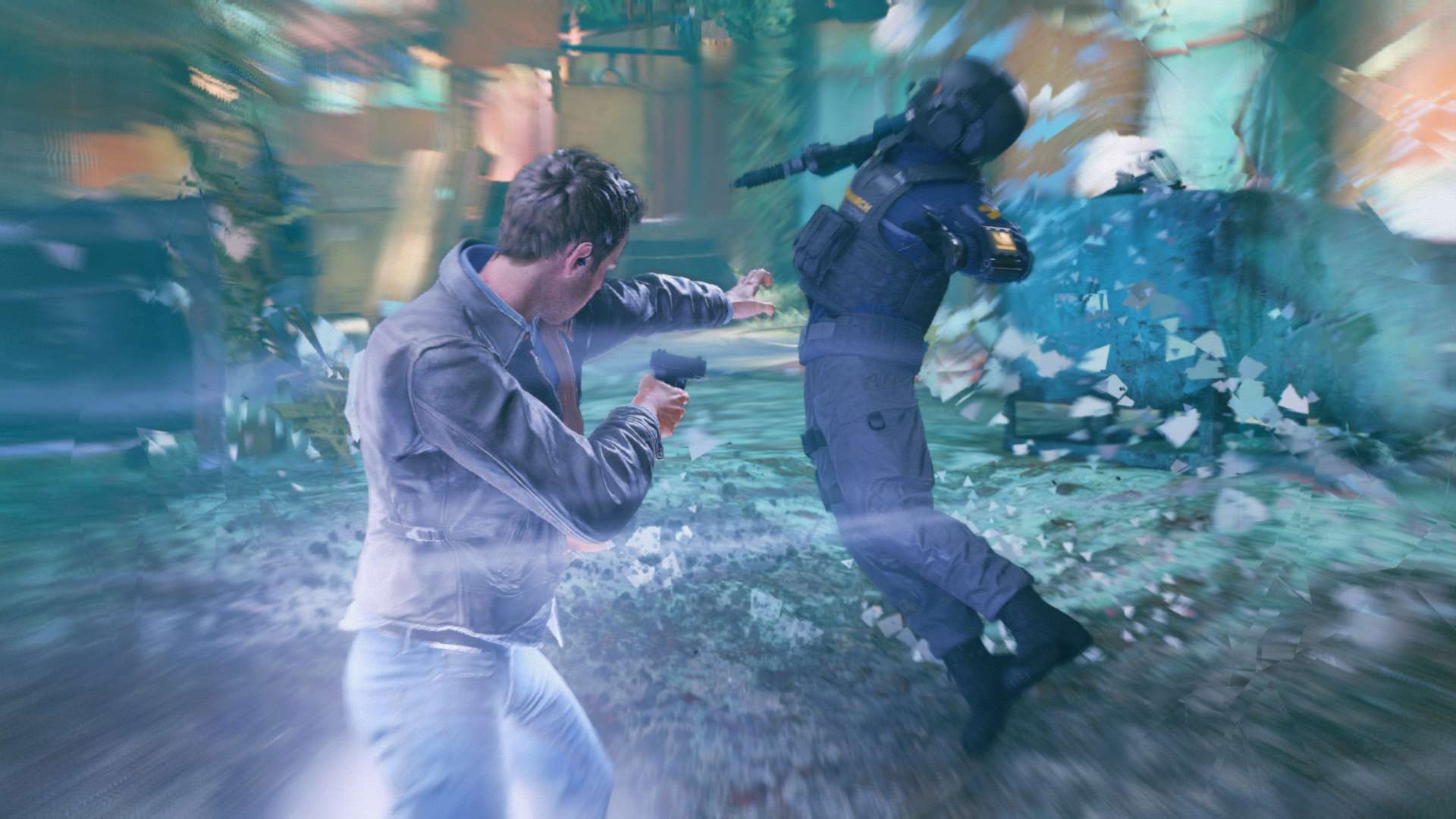Enemy, Spo-o-o-o-tted…
What if the world ended, and you were the only one who knew and the only one who could help. Remedy Entertainment’s Quantum Break proposes exactly this, putting you in the role of Jack Joyce, an average twenty-something whose brother, William, invents a time machine that inadvertently threatens to destroy the fabric of time. As Jack, you’re armed to the teeth with an arsenal of guns, and a ton of time-centric abilities.
Along the way, Jack can piece together what exactly happened via cutscenes and a bevy of narrative collectibles. On top of that, in between the campaign’s five-act structure are four twenty-two minute live-action TV episodes that expand the main narrative. The full scope of Quantum Break is big, so there’s enough content to take up much of a player's, um, time. But is the latest from the makers of Alan Wake a trip worth taking?
Opening with a literal bang, you are pushed to get up to speed fast. You, as Jack, have come to Riverport University at 4am to visit an old friend, Paul Serene, who is now a tech billionaire. Paul has been working on something monumental with William and can’t wait to show you the project, but won’t say a word until he actually sees it. As you make your way through to the metaphysics science building, there’s a creepily quiet atmosphere. You run into a student who wants you to know “the truth” about Paul’s global corporation, Monarch. "A Trust No One" poster adorning a dorm room would have fit right in.
Eventually, you reach the time machine, which looks like an oversized, metallic doughnut, and Serene convinces you to start up the machine. All of this is done through the now standard walk-and-talk, although as Jack, you’re never given the option to choose what exactly is said. Paul wants you there to bear witness to him being the first person to go forward through time, two minutes to be exact. As fate would have it, things don’t go well. (Shocker.) Suddenly, there are two Pauls and an army of Monarch security guards out to get you. Fortunately, the aforementioned blast that occurred when the machine was activated has gifted you with time powers. The problem is that the explosion also caused a fracture in time, one that if Paul and Jack’s brother are correct, will end time. Permanently.
So begins a contrived but mostly entertaining story, told in an overstuffed manner.
The game, as you may have seen from the numerous commercials, is tied to live-action material. As such, the main characters are voiced and mo-capped played by actors who’ve been in a number of movies and shows: antagonist Paul Serene is played by Game of Thrones’ own Littlefinger, Aiden Gillen; Shawn Ashmore, who most will remember as Iceman from the X-Men films, plays Jack; and Lance Reddick, best known from The Wire, plays Martin Hatch, the right hand man to Paul Serene. Hatch is the also the guy who gets to over-explain things, just like the actor did as Phillip Broyles on Fox’s Fringe.
Speaking of that Fox show that went off the air in 2013, the TV sections of Quantum Break, by today's standards, are terribly mediocre and feel like a less compelling version of the J.J. Abrams-produced monster-of-the-week hit, with a dollop of sibling character arcs à la Prison Break added for good measure. It’s kind of depressing to watch each segment as you can tell it has a budget, competent actors, mid-level FX for television, but all of it is either annoying or just plain dull. The plot mostly follows a guy named Liam Burke (Patrick Heusinger) who doesn't see a lot of screen time in the game proper, but is also trying to stop the end of the world. We live in an era of so many good TV shows so it can be easy to forget how hard it must be to actually make just a decent one. Think of something on television now that you think sucks. This is worse.
Okay, let's take it down a notch. Fringe is a great modern sci-fi show so how do these episodes, which amounts to over an hour of material, compare to other live-action stints in just video games? The most recent comparison would be to Halo's Forward Unto Dawn. As a propulsive narrative the edge goes to Quantum Break. The production value is better, the acting more believable, but they both suffer from a feeling of irrelevance compared to the game proper. Also, the visual FX in the live-action scenes look very obvious, though I think that decision was more to keep it in line with how it looks in the game.
At the end of acts 1–4, the live-action videos stream via your Xbox One unless you choose to download the 75 gigs of HD clips. It’s not worth it. Honestly, you can just skip them entirely, really, as the best parts of the story in Quantum Break aren’t in the show or even in-game cut scenes. Like so many games of late, the most compelling tidbits come from emails, journal entries, and other “narrative collectibles” that Jack can look over when he’s not being a badass mowing down faceless Monarch militia or using his time powers.
Then again, the game was hyped as giving you “a personalized version of the television show.” At certain junctures in the game, you see the story unfold from Paul’s POV. Time stops for a moment, and you'll need to choose one of two paths to proceed. Do you trust your advisor Hatch? Or do you put your faith in Doctor Sofia Amaral, the scientist that has supported Paul’s vision the whole time? Luckily, you can see how a scene plays out first and then confirm your choice. In some ways it does alter the game, but since most of our time is with Jack, we’re not really invested in Paul’s journey. If anything, I chose any option that would make Paul’s life harder. Also, beyond being in Jack’s head most of the time, we also don’t get to partake in any of Paul’s abilities, which being the bad guy, he has several.
The use of these junction points in time are meant to be replayed as a way to offer a glimpse of the ever-changing aspect of time in this story. Those interested in exploring both sides can think of them as fun bonuses, though as you might expect, the overall plot doesn't really change. One scene change might mean less Monarch soldiers to kil, or another might mean a campaign might have intel to get past certain areas easier. For completionists all you need to do is go to the menu, choose timeline, and then pick a junction point to reselect a junction choice if you desire to see all of the possible story variations.
There is a skill tree that can be used throughout the game, which is focused solely on Jack. You can purchase longer time stops, quicker health refresh, etc., by using Chronon sources you find in the game. Still, I played the game on Normal, and didn’t bother upping Jack’s abilities until near the end since the gameplay itself is quite fun, but never really challenging. Back in the day, Remedy developed the first two Max Payne games, so the jump from early 2000-era bullet-time to Quantum Break’s time enhancements makes sense.
Once you’ve got all your abilities, your main attack plan is to use time dodge to speed up and take out a guard like The Flash and hitting B to knock them down, thereby saving on ammo. Otherwise, you can shoot the rest of the enemies with your automatic rifle or handgun. You’ll want to save your shotgun, however, for the heavy-armored mini-boss types which take about five shots to kill on Normal. Occasionally, you’ll use the time freeze to stop certain soldiers. To the developers credit the action rarely gets boring. It’s only save points that can grate.
Just when you might get bored of taking down a horde of faceless Monarch agents, you can explore a room once an area is cleared… which brings up a weird, questionable trait of Quantum Break. Just as Remedy did in Alan Wake, there are a lot of items to collect while making your way between levels. Jack will enter a room and hitting Y activates the pretty much standard detective mode to see enemies in red and points of interest in yellow.
What’s odd is that on many occasions, other characters (or sometimes Jack himself) will want the player to move forward to the next area ASAP. A character might say “Hey, Jack, we should get going, right?” within a few seconds of entering. This happens a lot in action/adventure games, but the speed at which this game's NPCs alert you to get a move on and then doing it again several seconds later is grating. Quantum Break can't seem to decide whether you are supposed to look over all these collectibles or just keep moving forward.
Speaking of Jack’s narration, too many times when Jack is monologuing, other in-game dialogue moments get overlapped with two voices speaking at the same time. Almost like there’s a lot of voice recordings pre-loaded for each level, and the game just can’t wait to share it all with you. As for other technical issues, the use of time lapses is spotty or at least doesn’t seem to make sense. Why do I have to stand in a certain spot to activate it when the time ability affects the entire room? The few moments of platforming are pretty clunky too, which leads to falling off ledges unintentionally.
While the gameplay is fun and the story as silly as it is passable, the locations are disappointing. Whether at a school, a warehouse, a parking lot, or a skyscraper, the Monarch Solutions logos and assets are a constant, giving every area a similar vibe. The faux corporate art feels intentionally bland, and doesn’t make visiting these areas any more compelling. Another downside is some questionable checkpoints that make doing a level over and over a slog, even in a game that is about time repeating itself.
Despite some quite good late-in-the-story character beats, Quantum Break is still just another cautionary tale about time travel. It seems the one thing that never gets an alternate universe path is the notion that time is something that we should never mess with, which is kind of obvious by now. Perhaps this story could have bucked that trend. What saves Quantum Break, though, is the abundance of content and its integration of time-based abilities in combat. I might not have like the live-action episodes, but someone might especially when compared to narratives in other games. And there are all those narrative collectibles. This a game with something for everyone. None of it is exemplary, but as a weekend rental, it’s not a bad way to spend your, well, you know…
-
Fun, engaging gameplay
-
A fast-paced trip with a lot to do
-
Players pushed forward constantly when exploring is ALSO encouraged
-
Graphics are sharp, but a tad uninspired
-
Plenty of technical issues abound
-
Nothing really exemplary
Quantum Break review screenshots
-
Quantum Break review screenshots #1

-
Quantum Break review screenshots #2

-
Quantum Break review screenshots #3

-
Quantum Break review screenshots #4

-
Quantum Break review screenshots #5

-
Quantum Break review screenshots #6

-
Quantum Break review screenshots #7

-
Quantum Break review screenshots #8

-
Quantum Break review screenshots #9

-
Quantum Break review screenshots #10

-
Quantum Break review screenshots #11

-
Quantum Break review screenshots #12

-
Quantum Break review screenshots #13

-
Quantum Break review screenshots #14

-
Quantum Break review screenshots #15

-
Quantum Break review screenshots #16

-
Quantum Break review screenshots #17

-
Quantum Break review screenshots #18












